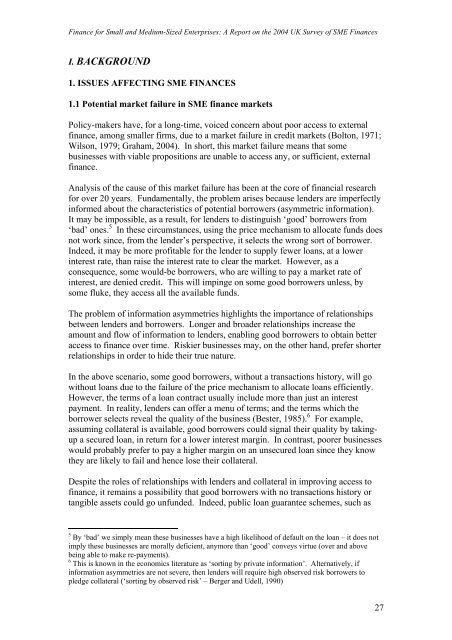Finance for Small and Medium-Sized Enterprises - DTI Home Page
Finance for Small and Medium-Sized Enterprises - DTI Home Page
Finance for Small and Medium-Sized Enterprises - DTI Home Page
Create successful ePaper yourself
Turn your PDF publications into a flip-book with our unique Google optimized e-Paper software.
<strong>Finance</strong> <strong>for</strong> <strong>Small</strong> <strong>and</strong> <strong>Medium</strong>-<strong>Sized</strong> <strong>Enterprises</strong>: A Report on the 2004 UK Survey of SME <strong>Finance</strong>s<br />
I. BACKGROUND<br />
1. ISSUES AFFECTING SME FINANCES<br />
1.1 Potential market failure in SME finance markets<br />
Policy-makers have, <strong>for</strong> a long-time, voiced concern about poor access to external<br />
finance, among smaller firms, due to a market failure in credit markets (Bolton, 1971;<br />
Wilson, 1979; Graham, 2004). In short, this market failure means that some<br />
businesses with viable propositions are unable to access any, or sufficient, external<br />
finance.<br />
Analysis of the cause of this market failure has been at the core of financial research<br />
<strong>for</strong> over 20 years. Fundamentally, the problem arises because lenders are imperfectly<br />
in<strong>for</strong>med about the characteristics of potential borrowers (asymmetric in<strong>for</strong>mation).<br />
It may be impossible, as a result, <strong>for</strong> lenders to distinguish ‘good’ borrowers from<br />
‘bad’ ones. 5 In these circumstances, using the price mechanism to allocate funds does<br />
not work since, from the lender’s perspective, it selects the wrong sort of borrower.<br />
Indeed, it may be more profitable <strong>for</strong> the lender to supply fewer loans, at a lower<br />
interest rate, than raise the interest rate to clear the market. However, as a<br />
consequence, some would-be borrowers, who are willing to pay a market rate of<br />
interest, are denied credit. This will impinge on some good borrowers unless, by<br />
some fluke, they access all the available funds.<br />
The problem of in<strong>for</strong>mation asymmetries highlights the importance of relationships<br />
between lenders <strong>and</strong> borrowers. Longer <strong>and</strong> broader relationships increase the<br />
amount <strong>and</strong> flow of in<strong>for</strong>mation to lenders, enabling good borrowers to obtain better<br />
access to finance over time. Riskier businesses may, on the other h<strong>and</strong>, prefer shorter<br />
relationships in order to hide their true nature.<br />
In the above scenario, some good borrowers, without a transactions history, will go<br />
without loans due to the failure of the price mechanism to allocate loans efficiently.<br />
However, the terms of a loan contract usually include more than just an interest<br />
payment. In reality, lenders can offer a menu of terms; <strong>and</strong> the terms which the<br />
borrower selects reveal the quality of the business (Bester, 1985). 6 For example,<br />
assuming collateral is available, good borrowers could signal their quality by takingup<br />
a secured loan, in return <strong>for</strong> a lower interest margin. In contrast, poorer businesses<br />
would probably prefer to pay a higher margin on an unsecured loan since they know<br />
they are likely to fail <strong>and</strong> hence lose their collateral.<br />
Despite the roles of relationships with lenders <strong>and</strong> collateral in improving access to<br />
finance, it remains a possibility that good borrowers with no transactions history or<br />
tangible assets could go unfunded. Indeed, public loan guarantee schemes, such as<br />
5 By ‘bad’ we simply mean these businesses have a high likelihood of default on the loan – it does not<br />
imply these businesses are morally deficient, anymore than ‘good’ conveys virtue (over <strong>and</strong> above<br />
being able to make re-payments).<br />
6 This is known in the economics literature as ‘sorting by private in<strong>for</strong>mation’. Alternatively, if<br />
in<strong>for</strong>mation asymmetries are not severe, then lenders will require high observed risk borrowers to<br />
pledge collateral (‘sorting by observed risk’ – Berger <strong>and</strong> Udell, 1990)<br />
27















![Joint Report on Social Protection and Social Inclusion [2005]](https://img.yumpu.com/19580638/1/190x132/joint-report-on-social-protection-and-social-inclusion-2005.jpg?quality=85)
